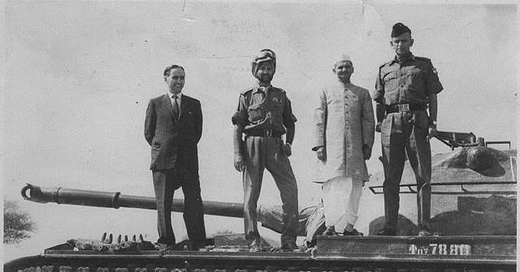By Ranjit Singh, editor Jagveer Singh
UPDATE
As we were writing this piece, the news came through from Trump that a ceasefire between India and Pakistan has been negotiated. Both India and Pakistan have stated that they would stop all firing and military action from 5PM Indian Standard Time (IST). This further highlights the point made in this piece that “international diplomatic pressures” were always going to more effective at achieving such things. That is the kind of level of influence the Khalsa needs to attain so it can apply real pressure quickly to minimise conflicts. These recent developments further the support the recommendations made at the end of this Vichaar.
No War In Punjab (?)
The following is a kind of a commentary on the sentiments we are observing being expressed on social media and our circles rather than an analysis of the conflict itself — which we may cover later once the fog of war has lifted a bit. Since misinformation campaigns and propaganda are part and parcel of modern warfare, it becomes difficult to determine hard facts so close to the beginning of a conflict. Instead, we thought it may be interesting to talk about how various Sikh sentiments seems to be evolving as the story develops.
A significant portion of Sikh social media currently seems to be echoing the slogan “#NoWarInPunjab”. However, the efficacy of such social media activism is debatable. While social media can shape public opinion and raise awareness, it seldom translates to direct political influence without substantial offline mobilisation or institutional backing. The outcomes of potential conflicts are more likely to be influenced by international diplomatic pressures or economic interests wielded by powerful multinational corporations and lobbying groups. While war can be lucrative for certain defence related industries, it is an overwhelmingly resource-intensive activity that risks broader economic interests, and strains domestic resources that could be applied elsewhere. Additionally, other nations who may view either (or both) of these countries as trade partners or strategic allies, would naturally have the incentive to want to deescalate, since if both nations become embroiled in war, the factors that initially made them attractive to partner or ally with may start become unattractive.
Given the interconnected nature of the global economy and political systems, conflict in South Asia could have wide reaching consequences that might pressure influential actors to advocate for de-escalation.
Additionally, both India and Pakistan have large diasporic communities in the West. Heightened tensions between these nations may reverberate in these countries, leading to increased pressure form Western governments that host these communities to mediate or de-escalate the conflict so to reduce tensions in their countries.
Conversely, both India and Pakistan also have substantial patriotic voter bases, particularly those who are not directly at risk but are egging it on from the sidelines out of their nationalist fervour. This is only exacerbated by the propaganda efforts of state-backed (or owned) media outlets in both nations. This dynamic creates a counter pressure for the governments to maintain a stance of strength to avoid public humiliation or perceived weakness.
In this wider context, Sikh voices appears to be largely marginal if not outright irrelevant. Demographically, Sikhs do not constitute a sufficiently large vote bloc outside of Punjab (and even this is diminishing with emigration) to exert significant political pressure. Furthermore, the sentiment among Sikhs themselves in India and abroad remains somewhat ambiguous and seemingly fragmented.
Regardless of all this, Sikhs will likely continue “doing their part” and ticking the box of social media activism, as they often do with most issues rather than make or at lest, advocate for tangible and strategic long term steps that put us in better positions in future so that we too may become influential actors on the world stage, able to apply real pressures to secure the outcomes we want - rather than be helpless victims of conflicts we did not consent to be a part of.
In the diaspora, Khalistani factions unsurprisingly adopt anti-India stances, and are either neutral or aligning with Pakistani narratives. However, the noticeable trend among most Sikhs on social media seems to lean towards advocating for peace through the "No War In Punjab" campaign. This is an interesting observation in of itself, since it puts into question the actual support rate for Neo-Khalistanis in particular — an extremist and distinct subsection of (anti-)Khalistanis — who call for armed struggle as a viable strategy to get a Khalistan today. If armed struggle is our only solution currently, then why aren’t Sikhs defending the borders of Panjab against India and Pakistan?
The question is, would a war initiated by Khalistanis in pursuit of Khalistan also be met with the same "No War In Punjab" rhetoric? Maybe not. The context of conflict matters, and so a war framed as a struggle for “Sikh sovereignty” in the form of Khalistan might evoke a different emotional response among many Sikhs, particularly those who feel alienated or marginalised by the Indian state. In such a scenario, the optics of the conflict could be cast as a more justifiable fight for self-determination, potentially galvanising support from certain segments of the diaspora as well as those within Panjab who harbour lingering grievances over historic injustices like the 1984 Sikh Genocide and the subsequent crackdown on militancy in the 1990s.
However, we already have a recent historical precedent to draw lessons from. During the 1980’s and 1990s, whilst support for armed struggle may have appeared widespread towards the start, after the Indian government’s attack on Harmandir Sahib in 1984 and the subsequent Sikh genocide, by the mid/late-1990s, it had dissipated significantly within Panjab. The Punjab populace had already borne the brunt of protracted conflict, witnessing firsthand the devastation of modern insurgency and counterinsurgency operations, with thousands killed, disappeared, or displaced. Additionally, despite the ideological fervor of some Khalistani factions, the material reality is clear. There has been no substantial advancement in Sikh military capabilities since the 1990s, nor any cohesive, organised military structure capable of sustaining a viable armed struggle.
On the other hand, there are Sikhs (based in India) who are patriotically supporting India in the conflict, claiming that the attack was justified due to the events in Kashmir and that it is Pakistan who should be held responsible for any escalation. This stance illustrates a crucial dichotomy within the Sikh community: while some are driven by anti-state sentiments rooted in the traumas of 1978, 1984 and its aftermath, others align with broader nationalist narratives, particularly those shaped by state media and mainstream Indian political discourse. This patriotic cohort often perceives Pakistan as a persistent external threat and may view any resistance against the Indian state as a betrayal rather than a legitimate call for sovereignty.
Another intriguing sentiment observed is the confusion regarding why Sikhs of all people, given their martial history, would oppose war. On the surface, it seems paradoxical, considering Sikhi’s historic and philosophical engagement with the concept of war. However, the reality is that the nature of war has evolved significantly. During the human-Guru period, battles were more localised and typically confined to defined battlefields, with non-combatant populations generally spared unless under siege. Although civilian populations may have been targeted, the scale of it would generally have been far different than is today given modern weaponry and tactics. Today, civilian collateral damage is almost a given in modern warfare, where high-impact strikes, drone bombings, and heavy artillery are commonplace.
Now, the conduct of war today in many ways resembles that of feuding farmers, rather than based on any real consistent pursuit for justice and respect for humanity. Instead of seeking rational reconciliation, it is as if one farmer, upon having his cattle harmed by another, responds by harming the other’s livestock, perpetuating a cycle of senseless destruction. There is few degrees of separation between the actual human cost behind these actions and those in power, who are far removed from the frontlines and insulated by layers of bureaucracy. These decision-makers, rather than confronting the visceral reality of conflict, reduce human lives to strategic calculations, weighing how many of “their cattle” can be sacrificed to inflict greater damage on “the other’s cattle.”
To summarise, the Sikh response to the conflict will likely fall into three broad categorise that seem to be prevalent so far:
Sikhs in general, within the diaspora but also in Panjab itself, will likely display their discontent for war, primarily on social media for a few weeks (which hopefully is also the time span this conflict is restricted to), before subsiding, as is typical with online campaigns.
Khalistanis will adopt various stances, some focusing exclusively on anti-India rhetoric while others may align with Pakistani narratives. Ultimately they will use the conflict as an opportunity to highlight why a separate Sikh state is the only solution.
Whereas Indian Nationalist Sikhs, who align with the Indian government will likely endorse the government’s actions as justified, citing events in Kashmir as provocation. They may dismiss dissenting voices as disloyal or traitorous, emphasising a national unity over regional or diaspora concerns.
However, very few, if any, of these groups are likely to seize this moment for serious self reflection regarding why Sikhs remain largely powerless in such scenarios. Instead of merely reacting to external events, the focus should shift towards long-term strategies to position Sikhs as influential actors capable of shaping outcomes rather than being passive observers or victims. The Khalsa in particular should already have been in positions where they are able to apply pressures in directions that safeguard both Sikh interests and the wider welfare of all humans (Sarbat Da Bhalla).
One such strategy is the Dharam Yudh Pipeline, a proposed initiative aimed at mobilising young Sikhs to pursue careers in law enforcement, armed forces, intelligence, and legal professions. The goal is to establish a whole industry of Khalsa Private Military Security Companies (PMSCs), Conflict Resolution Organisations (CROs), Intelligence Agencies, and Private Law Firms (PLFs). Such institutions would not only provide practical and tactical support to the Sikh community in times of crisis but also serve as mechanisms of applying soft and hard power, enabling Sikhs to effectively advocate for and secure their interests on both domestic and international stages. If the Khalsa want to have leverage on the world stage, then it must do more than social media activism and rebuild the Guru Khalsa Panth’s soft and hard power, legally, ethically, effectively.
For more information of the Dharam Yudh Pipeline, read the white paper at BungaAzaadi.com. For those wanting to take personal responsibility and upskill themselves with modern tactical training, visit MislNet.com. Misl Net offers courses delivered by real-world experts, covering key areas such as hostile environment awareness training (HEAT), firearms proficiency, close protection, intelligence training and more. Misl Net also has an Intel Substack summarising and producing report guides and podcasts from the latest research published by leading defence think tanks. In this age of information warfare, intelligence is important weapon. Arm yourself with knowledge. Stay informed, stay ahead. Additionally, for a specifically Sikh focused perspective on defence matters, follow the
Institute on Instagram and Substack also — the world’s first Sikh Defence Think Tank.Lastly, let us know your thoughts. Agree, disagree? Share your Vichaars in the comments or reach out if you’d like to write for us or collaborate on any of these topics.

















Share this post